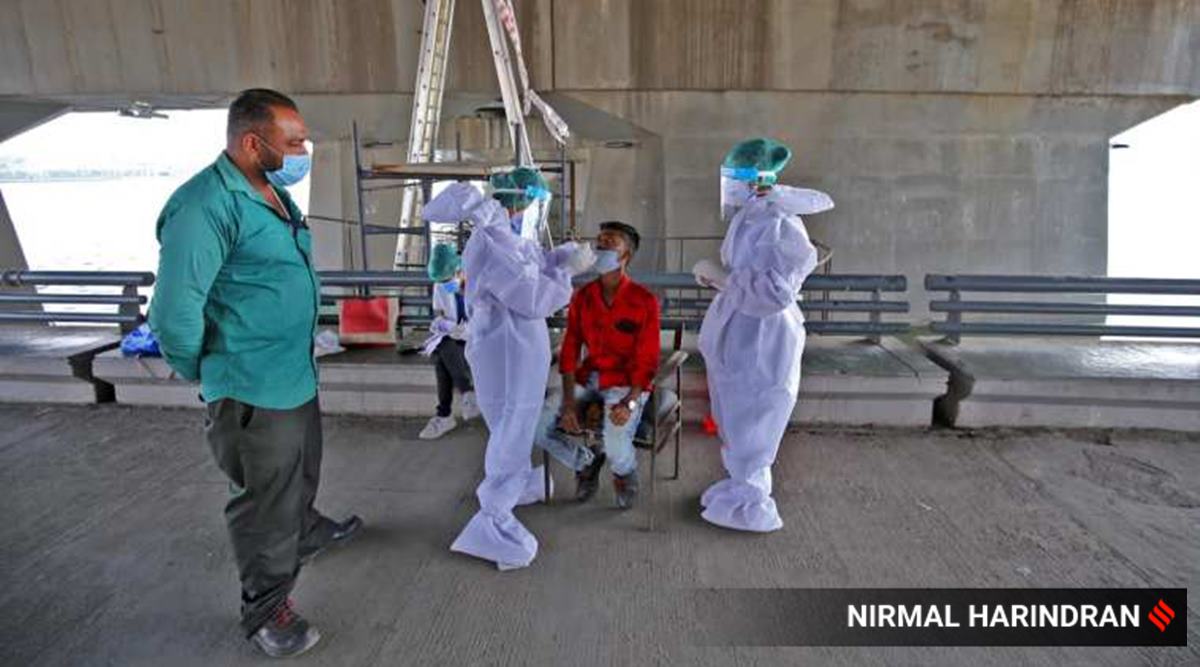 State officials attributed the rise to an intensive drive to detect more infections. (Express Photo/Used for representational purpose)
State officials attributed the rise to an intensive drive to detect more infections. (Express Photo/Used for representational purpose)THE INCREASE in Covid-19 testing as a means to isolate “super spreaders” has led to a gradual rise in positive cases in Mumbai this week. On Thursday, 924 cases were reported, up from 871 on Wednesday, and 504 on Tuesday.
State officials attributed the rise to an intensive drive to detect more infections. The BMC is running 58 Covid-19 centres, including quarantine facilities and hospitals, but can start 35 more within two days’ notice in case of a second wave, they said.
At present, only 10 per cent beds are occupied across all Covid care facilities. On Wednesday, state Environment Minister Aaditya Thackeray held a review meeting with civic officials to oversee preparations for an anticipated second wave. Officials said they could start some more centres within eight days’ notice.
“For oxygen supply, we have arranged turbo facility, so there will be no need of cylinders at jumbo centres,” a BMC official said.
The state government has warned against a possible post-Diwali second wave, that may become apparent by December. Each district has been asked to measure its peak, the day when maximum cases were recorded in the last wave, and add 10 per cent more cases to it and prepare for beds accordingly. “Right now, several districts have converted some rural and civil hospitals back into non-Covid facilities, as per low caseload. If cases start rising again, we will convert these hospitals back into Covid centres,” said N Ramaswamy, director of National Health Mission.
A state health official said daily tests had reduced to between 40,000 and 50,000 due to a consistently declining positivity rate — now below 10 per cent. “Since we are not finding positive cases, we had reduced total tests. Low-risk contacts are asked to come for testing if they have symptoms and only high risk are observed and tested if needed,” said the state official.
But Dr Subhash Salunkhe, technical adviser to the state government, said it has been recommended to scale up testing and target hawkers, food vendors, and shop owners across Maharashtra.
Mumbai is already following the protocol and increased its testing this week to cover possible “super-spreaders” at marketplaces. Diwali festivities led to an increase in shopping and social mixing, and hawkers and shop owners remain at highest risk of infection.
On Wednesday, 11,493 tests were conducted, up from 6,539 on Tuesday and 3,918 on Monday. Subsequent cases also rose slightly from 409 on Monday to 541 on Tuesday and 871 on Wednesday, and finally 924 on Thursday.
The BMC said it was ready to handle a second wave. Officials said they had enough stock of medicines and equipment for Covid patients. The civic body will keep all jumbo facilities open till the end of December if cases did not rise. According to BMC data, there are over 70,000 beds across quarantine centres and hospitals. While Covid Care Centre 1 are for high-risk contacts, Covid Care Centre 2 are for those who have mild symptoms. There are 46,677 beds in the first centre and 23,806 in the second.
A simulation report by Tata Institute of Fundamental Research on October 29 indicated that intermingling during Diwali, or later during Chhath and Christmas may result in a second wave, but fewer infections could be reported as compared to a previous spike noted after Ganpati celebrations. This would be due to a larger population being exposed to Covid-19 and developing immunity to it.
“Of course, if there is substantial increase in interaction among the population during upcoming festivals and social distancing/mask related precautions are relatively weakened, then one may again see a significant rise in infections,” the report stated.
Edot: Rise in cases in Mumbai, not across state
A recent rise in Covid-19 cases could be due to increase in targeted testing in Mumbai as a special post-Diwali drive. If the trend continues, it may be indicative of a second wave. For now, only Mumbai is recording a gradual rise in positive cases, not the entire state. TIFR simulations predict by mid-January 2021, the prevalence of infection can stabilise close to 80 per cent in slums and 55 per cent in non-slum areas indicating more or less herd immunity.